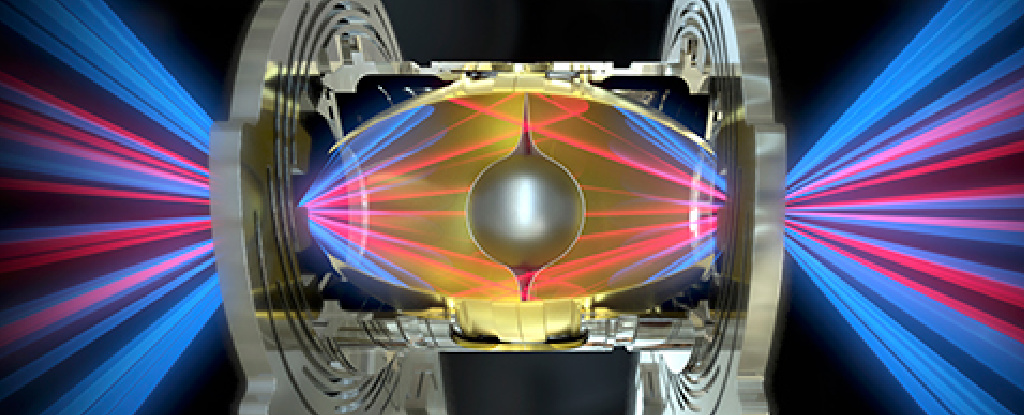
Posted on 02/07/2024 6:58:26 AM PST by Red Badger

(Jacob Long/Lawrence Livermore National Laboratory) In December 2022, scientists at the US National Ignition Facility announced a historic milestone: for the first time, their laser-powered fusion reaction had 'broken even', producing more energy than it consumed.
But advances as big as this need to be rigorously checked – and that can take some time.
Importantly, a series of papers detailing the experimental design, technological advancements, and results of the initial breakthrough reaction have just passed peer review, meaning researchers not involved in the work have vetted the methods and findings in order to check the sums.
"This achievement is the culmination of more than five decades of research and gives proof that laboratory fusion, based on fundamental physics principles, is possible," the team members of the Indirect Drive ICF (inertial confinement fusion) Collaboration write in the first of five papers.
Nuclear fusion, if harnessed and scaled up, promises an abundant, inexhaustible source of clean energy without the greenhouse gas emissions of fossil fuels or the radioactive waste of nuclear fission. Fusion is the merging of two or more atoms to form a larger atom, releasing energy in the process.
These lab-based reactions are a far cry from commercial-scale applications, mimicking the fusion reactions powering our Sun and stars on a tiny scale. Without the Sun's mass to provide some gravitational grunt, methods for fusing atoms on Earth rely on heat.
In the case of this particular fusion technology, that heat is delivered via a powerful burst of light. The experiments involve bombarding a capsule containing a measly 220 micrograms of deuterium and tritium fuel with 192 high-powered lasers, which raises the pressure to 600 billion atmospheres and the temperature to 151 million °C (272 million °F).
These conditions, which far exceed those inside the Sun, cause the fuel to implode, the deuterium and tritium atoms fusing into helium and unleashing energy.
In the breakthrough experiment of December 2022, lasers fired 2.05 megajoules (MJ) of energy into the fuel, resulting in 3.15 MJ being released – so roughly 1.5 times more energy was produced by the reaction than was delivered into the fuel.
The new papers detail the progress that made 'breaking even' possible, including tinkering with the fuel mix, eliminating defects in the capsule walls, increasing the mass of the pea-sized capsule, boosting laser energies, and upping the volume of fuel used.
Passing that so-called ignition threshold heralded a new era of fusion research, which hasn't slowed down since: researchers have fired more energetic lasers and produced even more energy in several experiments last year.
The researchers also report results from one of those more recent experiments, from mid-2023, which generated 3.88 MJ of energy from the same 2.05 MJ energy input – about 1.9 times the energy injected, which is the highest yield to date.
Bear in mind, however, that huge amounts of energy are used to power the lasers in these experiments: 500 trillion watts, or a thousand times more power than the US national energy grid produces at any instant. So there's a long way to go before these fusion reactions actually generate more energy than goes into setting them off.
"There is a chance that we will have fusion," Martin Freer, a nuclear physicist at the University of Birmingham, told New Scientist's Matthew Sparks. "But the challenges that we have are pretty steep, scientifically."
Despite its promise of clean energy, scientists also stress that nuclear fusion is not the immediate solution we need for the climate crisis.
Commercial nuclear fusion facilities are still decades away, says University of Manchester nuclear fusion researcher Aneeqa Khan, when we need to almost halve global carbon emissions in the next 6 years – by 2030 – to turn the climate around.
Luckily, we already have the renewable energy technologies to do that.
The five papers have been published in Physical Review Letters, which you can read here, here, here, here, and here.
https://journals.aps.org/prl/abstract/10.1103/PhysRevLett.132.065102
https://journals.aps.org/pre/abstract/10.1103/PhysRevE.109.025204
https://journals.aps.org/prl/abstract/10.1103/PhysRevLett.132.065103
https://journals.aps.org/prl/abstract/10.1103/PhysRevLett.132.065104
https://journals.aps.org/pre/abstract/10.1103/PhysRevE.109.025203
adjective
Having little or no detrimental effect; harmless.
"a benign chemical; benign indifference.
Of no danger to health; not malignant or disease-causing.
"a benign tumor."
Tending to exert a beneficial influence; favorable.
"a policy with benign consequences for the economy."
The American Heritage® Dictionary of the English Language, 5th Edition • More at Wordnik
End of discussion, please.
“End of discussion, please.”
I know the definition. That is why I posted it to be less benign. That is, more harmful’
Did you know the half life of a single proton in the Sun is billions of years? Once it does finally become Deuterium its half life is about a minute.
Which do want a tumor to be? More or less benign.
Thorium has a more benign decay series meaning it is less harmful.
Seriously, end this please.
I don’t know the future holds be it just may be far cheaper to burn dollars to keep warm then anything these yokels are coming up with...
Disclaimer: Opinions posted on Free Republic are those of the individual posters and do not necessarily represent the opinion of Free Republic or its management. All materials posted herein are protected by copyright law and the exemption for fair use of copyrighted works.